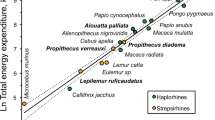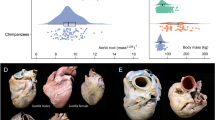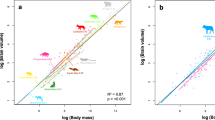Abstract
The human brain stands out among mammals by being unusually large. The expensive-tissue hypothesis1 explains its evolution by proposing a trade-off between the size of the brain and that of the digestive tract, which is smaller than expected for a primate of our body size. Although this hypothesis is widely accepted, empirical support so far has been equivocal. Here we test it in a sample of 100 mammalian species, including 23 primates, by analysing brain size and organ mass data. We found that, controlling for fat-free body mass, brain size is not negatively correlated with the mass of the digestive tract or any other expensive organ, thus refuting the expensive-tissue hypothesis. Nonetheless, consistent with the existence of energy trade-offs with brain size, we find that the size of brains and adipose depots are negatively correlated in mammals, indicating that encephalization and fat storage are compensatory strategies to buffer against starvation. However, these two strategies can be combined if fat storage does not unduly hamper locomotor efficiency. We propose that human encephalization was made possible by a combination of stabilization of energy inputs and a redirection of energy from locomotion, growth and reproduction.
This is a preview of subscription content, access via your institution
Access options
Subscribe to this journal
Receive 51 print issues and online access
$199.00 per year
only $3.90 per issue
Buy this article
- Purchase on Springer Link
- Instant access to full article PDF
Prices may be subject to local taxes which are calculated during checkout



Similar content being viewed by others
References
Aiello, L. C. & Wheeler, P. The expensive-tissue hypothesis—the brain and the digestive system in human and primate evolution. Curr. Anthropol. 36, 199–221 (1995)
Mink, J. W., Blumenschine, R. J. & Adams, D. B. Ratio of central nervous system to body metabolism in vertebrates—its constancy and functional basis. Am. J. Physiol. 241, R203–R212 (1981)
Bruhn, J. M. & Benedict, F. G. The respiratory metabolism of the chimpanzee. Proc. Am. Acad. Arts Sci. 71, 259–326 (1936)
Wrangham, R. Catching Fire: How Cooking Made Us Human (Basic Books, 2009)
Aiello, L. C., Bates, N. & Joffe, T. in Evolutionary Anatomy of the Primate Cerebral Cortex (eds Dean, F. & Gibson, K. ) 57–78 (Cambridge Univ. Press, 2001)
Kaufman, J. A., Hladik, C. M. & Pasquet, P. On the expensive-tissue hypothesis: independent support from highly encephalized fish. Curr. Anthropol. 44, 705–707 (2003)
Isler, K. & van Schaik, C. P. Costs of encephalisation: the energy trade-off hypothesis tested on birds. J. Hum. Evol. 51, 228–243 (2006)
Jones, K. E. & MacLarnon, A. M. Affording larger brains: testing hypotheses of mammalian brain evolution on bats. Am. Nat. 164, E20–E31 (2004)
Potts, R. Environmental hypotheses of hominin evolution. Yearb. Phys. Anthropol. 107, 93–136 (1998)
Mau, M., Südekum, K.-H. & Kaiser, T. M. Why cattle feed much and humans think much—new approach to confirm the expensive tissue hypothesis by molecular data. Biosci. Hypotheses 2, 205–208 (2009)
Pfefferle, A. D. et al. Comparative expression analysis of the phosphocreatine circuit in extant primates: implications for human brain evolution. J. Hum. Evol. 60, 205–212 (2011)
Santoro, S. et al. Preliminary results from digestive adaptation: a new surgical proposal for treating obesity, based on physiology and evolution. Sao Paulo Med. J. 124, 192–197 (2006)
Pond, C. M. The Fats of Life (Cambridge Univ. Press, 1998)
Sol, D. Revisiting the cognitive buffer hypothesis for the evolution of large brains. Biol. Lett. 5, 130–133 (2009)
van Woerden, J. T., van Schaik, C. P. & Isler, K. Effects of seasonality on brain size evolution: evidence from strepsirrhine primates. Am. Nat. 176, 758–767 (2010)
Garland, T. Scaling the ecological cost of transport to body mass in terrestrial mammals. Am. Nat. 121, 571–587 (1983)
Reader, S. M., Hager, Y. & Laland, K. N. The evolution of primate general and cultural intelligence. Philos. Trans. R. Soc. B 366, 1017–1027 (2011)
Martin, R. D. Relative brain size and basal metabolic rate in terrestrial vertebrates. Nature 293, 57–60 (1981)
Isler, K. & van Schaik, C. P. The expensive brain: a framework for explaining evolutionary changes in brain size. J. Hum. Evol. 57, 392–400 (2009)
Isler, K. & van Schaik, C. P. Metabolic costs of brain size evolution. Biol. Lett. 2, 557–560 (2006)
Isler, K. Energetic trade-offs between brain size and offspring production: marsupials confirm a general mammalian pattern. Bioessays 33, 173–179 (2011)
Wells, J. C. K. The Evolutionary Biology of Human Body Fatness (Cambridge Univ. Press, 2009)
Zihlman, A. L. in The Pygmy Chimpanzee (ed. Susman, R. L. ) 179–200 (Plenum Press, 1984)
Aiello, L. C. & Wells, J. C. K. Energetics and the evolution of the genus Homo. Annu. Rev. Anthropol. 31, 323–338 (2002)
Kaplan, H., Hill, K., Lancaster, J. & Hurtado, A. M. A theory of human life history evolution: diet, intelligence, and longevity. Evol. Anthropol. 9, 156–185 (2000)
Burkart, J. M., Hrdy, S. B. & van Schaik, C. P. Cooperative breeding and human cognitive evolution. Evol. Anthropol. 18, 175–186 (2009)
Pontzer, H. et al. Locomotor anatomy and biomechanics of the Dmanisi hominins. J. Hum. Evol. 58, 492–504 (2010)
Pontzer, H., Raichlen, D. A. & Sockol, M. D. The metabolic cost of walking in humans, chimpanzees, and early hominins. J. Hum. Evol. 56, 43–54 (2009)
Isler, K. & van Schaik, C. P. Why are there so few smart mammals (but so many smart birds)? Biol. Lett. 5, 125–129 (2009)
Dean, C. et al. Growth processes in teeth distinguish modern humans from Homo erectus and earlier hominins. Nature 414, 628–631 (2001)
Pitts, G. & Bullard, T. in Body Composition in Animals and Man (ed. Reit, J. T. ) 45–70 (National Academy of Science Pub No. 1598, 1968)
Isler, K. et al. Endocranial volumes of primate species: scaling analyses using a comprehensive and reliable data set. J. Hum. Evol. 55, 967–978 (2008)
Rehkämper, G., Frahm, H. D. & Zilles, K. Quantitative development of brain and brain structures in birds (Galliformes and Passeriformes) compared to that in mammals (Insectivores and Primates). Brain Behav. Evol. 37, 125–143 (1991)
Orme, D., Freckleton, R. P., Thomas, G., Petzoldt, T. & Fritz, S. CAIC: Comparative Analyses Using Independent Contrasts 〈http://r-forge.r-project.org/projects/caic〉 (2009)
R Development Core Team . R: a language and environment for statistical computing (R Foundation for Statistical Computing, 2010)
Acknowledgements
We thank R. D. Martin and J. Wermuth for sharing the Chivers data set, J. van Woerden for sharing her endocranial volume data, and M. Genoud for sharing his revised compilation of mammalian BMR values. Specimens were provided by numerous institutions, museums and colleagues (Supplementary Information 2). We acknowledge valuable comments by L. Aiello and R. D. Martin. Financial support was provided by the Swiss National Science Foundation (grant number 3100A0-117789), the A.H. Schultz-Stiftung and the European Integrated Activities grant SYNTHESYS (grant application number HU-TAF-4916).
Author information
Authors and Affiliations
Contributions
K.I. and C.P.v.S. designed the project. A.N. performed the pilot study and collected the data. A.N. and K.I. performed the analyses and all three authors wrote the manuscript.
Corresponding authors
Ethics declarations
Competing interests
The authors declare no competing financial interests.
Supplementary information
Supplementary Information
This file contains Supplementary Text comprising Supplementary Data, Supplementary Methods, Supplementary Results and Discussion (see Content list for more details); Supplementary Figures 1-3 with legends; Supplementary Tables 1-11 and additional references. (PDF 1377 kb)
Supplementary Data (Navarette_SupplData)
This file displays the compiled dataset of organ mass and metabolic data for 100 mammal species. (XLS 70 kb)
Rights and permissions
About this article
Cite this article
Navarrete, A., van Schaik, C. & Isler, K. Energetics and the evolution of human brain size. Nature 480, 91–93 (2011). https://doi.org/10.1038/nature10629
Received:
Accepted:
Published:
Issue Date:
DOI: https://doi.org/10.1038/nature10629
This article is cited by
-
Does the expensive brain hypothesis apply to amphibians and reptiles?
BMC Ecology and Evolution (2023)
-
Fermentation technology as a driver of human brain expansion
Communications Biology (2023)
-
From fossils to mind
Communications Biology (2023)
-
Constraining the Likely Technological Niches of Late Middle Pleistocene Hominins with Homo naledi as Case Study
Journal of Archaeological Method and Theory (2021)
-
Intraspecific macroscopic digestive anatomy of ring-tailed lemurs (Lemur catta), including a comparison of frozen and formalin-stored specimens
Primates (2021)
Comments
By submitting a comment you agree to abide by our Terms and Community Guidelines. If you find something abusive or that does not comply with our terms or guidelines please flag it as inappropriate.



